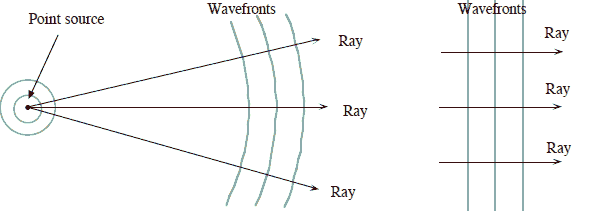

Electromagnetic waves with wavelengths λ in the range of ~400 nm to ~750 nm are called visible light. Maxwell's equations require that the speed v of any electromagnetic wave is v = (1/(µ0ε0)1/2 = 3*108 m/s in free space. Electromagnetic waves can travel through transparent media, such as water and glass. In a medium, they interact with the atoms or molecules, and due to this interaction have an apparent speed different from c. When electromagnetic waves travel through a transparent medium, the speed of the waves in the medium is v = c/n, where n is the index of refraction of the medium. The index of refraction n is a property of the material. For visible light in transparent materials it is, in general, greater than 1, so that v is less than c in the material. In most transparent materials the index of refraction depends slightly on the wavelength of the light, and in some materials it depends on the polarization.
The index of refraction of a material depends of the wavelength. Normal dispersion results in decreasing n with increasing wavelength. Optical glasses are characterized by an index of refraction nD and a quantity known as the dispersion ν, where
ν = (nF - nC)/(nD - 1).
Here nF, nD, and nC denote the indexes of refraction at three specific wavelengths. Standard emission lines are used to designate these wavelengths following the original nomenclature of Fraunhofer for prominent lines in the Solar spectrum. For crown glass we have:
nF = 1.52933 (486.1 nm)
nD = 1.52306 (589.0 nm)
nC = 1.52042 (656.3 nm)
Anomalous dispersion results from absorption structure. In this case there are discontinuities in n across the spectrum caused by absorption bands peculiar to the medium. The refractive index is seen to increase or jump up as the wavelength increases. All substances exhibit anomalous dispersion in certain wavelength regions.
Most materials are not transparent to visible light, but absorb or scatter light. Even in transparent materials a small (or not so small, depending on the purity of the material,) fraction of the light is absorbed or scattered.
We see light because it stimulates the cells in our eyes. Because our eyes are able to distinguish between different wavelength of light we perceive color. If the light reaching our eyes contains a broad mixture of wavelength, we interpret it as white light. Because light is an EM wave, it exhibits several behaviors characteristic of waves such as reflection, refraction and diffraction.
| A wave front is an imaginary surface representing corresponding points of a wave that vibrate in unison. The wave fronts of light emitted by a point source are concentric spheres, centered on the source and expanding away from the source at the speed of light. |
|
| A light ray is an
imaginary directed line perpendicular to the wave front. At a large
distance from the source the curvature of the wave front can be
neglected and the wave front appears flat. The wave is then approximated
by a plane wave and the light rays are parallel.
A beam of light has a non-zero width. We usually represent it by a few rays.
|
 |